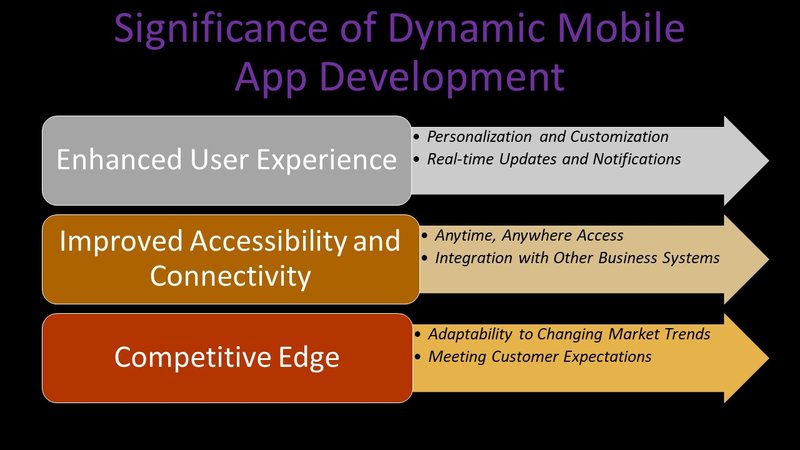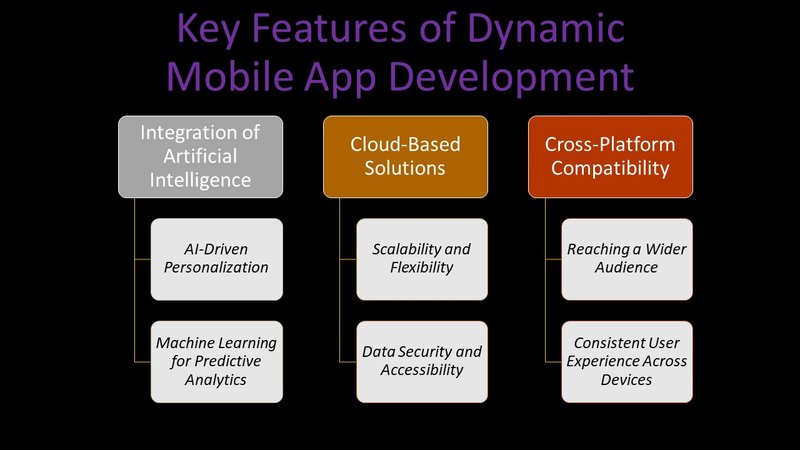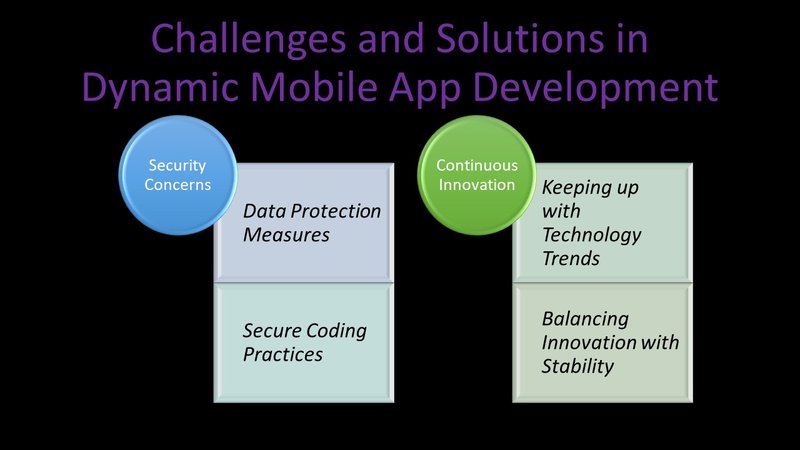Revolutionizing Business with Dynamic Mobile App Development
Dynamic mobile app development is a technological advancement that distinguishes itself from static rivals by providing adaptability and interactivity. These apps go beyond static limitations by reacting to real-time data and user behavior, resulting in a more agile and user-centric experience. Dynamic mobile app development has a transformative impact on enterprises, functioning as a catalyst for innovation. These apps improve user experiences, streamline operations, and create a competitive advantage by quickly adjusting to market developments. As a result, the company environment is more resilient and future-ready.

This article underlines the critical necessity of dynamic mobile app development in redefining core business activities in the ever-changing digital ecosystem. Dynamic applications are strategic assets that enable firms to survive in an environment where adaptability and innovation are essential. Dynamic mobile app development is a critical component in reshaping corporate landscapes, from tailored user experiences to increased operational efficiency.
The Evolution of Mobile Apps in Business

The origins of mobile app development may be traced back to the early days of rudimentary functionality. The introduction of smartphones in the mid-2000s heralded a new age in which mobile app capabilities expanded in line with rapid technology improvements.
The transition from static to dynamic mobile apps is a watershed moment. Static apps with fixed functionalities predominated at first, but the demand for interactive and responsive experiences propelled the growth of dynamic apps. These applications break free from the confines of static predecessors by adapting to user input, real-time data, and changing contexts.
Mobile apps are not only conveniences in today's business scene; they are critical tools. Businesses of all sizes use them to improve communication, streamline procedures, and engage with customers. Mobile apps are key components in designing current company practices, seamlessly integrating into operations for increased efficiency, broader reach, and greater customer experiences.
Significance of Dynamic Mobile App Development

A. Enhanced User Experience
- Personalization and Customization: Personalization of user experiences is synonymous with dynamic mobile app development. These apps go beyond one-size-fits-all solutions by providing consumers with personalized interactions. Dynamic apps deliver an immersive and unique journey for each user, from customizable interfaces to tailored content recommendations.
- Real-time Updates and Notifications: Dynamic mobile apps stand out due to their real-time reactivity, which keeps users informed and interested. Real-time updates and notifications keep users in the know about the newest promotions, account activity, and important information. This feature improves user engagement while also adding a sense of urgency to the app experience.
B. Improved Accessibility and Connectivity
- Anytime, Anywhere Access: Dynamic mobile apps break down time and geographical constraints. Users can access these apps at any time and from any location, resulting in a more seamless experience. The anytime, anywhere access function improves ease and usability, whether it's monitoring updates on the go or accessing crucial information remotely.
- Integration with Other Business Systems: Dynamic mobile app integration capabilities are critical in boosting accessibility. These apps interface smoothly with other business systems, resulting in a unified and linked digital ecosystem. This not only streamlines operations but also improves overall corporate efficiency.
C. Competitive Edge
- Adaptability to Changing Market Trends: Adaptability is a critical success component in today's volatile corporate environment. Businesses may be nimble and responsive to changing market trends by using dynamic mobile apps. The versatility of these apps guarantees that organizations can change alongside the market, whether it's adding new features or shifting strategy.
- Meeting Customer Expectations: Meeting and exceeding client expectations is critical to corporate success. With their individualized experiences and real-time updates, dynamic mobile apps not only match but frequently exceed, user expectations. This not only increases client loyalty but also sets the company ahead of competitors in terms of providing a greater user experience.
Key Features of Dynamic Mobile App Development

A. Integration of Artificial Intelligence
- AI-Driven Personalization: The use of Artificial Intelligence (AI) is one of the essential aspects that distinguishes dynamic mobile app development. These apps use AI-driven personalization to modify experiences based on user behavior and preferences. AI ensures that each user encounter is uniquely created to match individual needs, from personalized content recommendations to customized user interfaces.
- Machine Learning for Predictive Analytics: Machine learning algorithms are used in dynamic mobile apps for predictive analytics. These apps can predict user preferences and actions by examining patterns and data trends. This not only improves the user experience by delivering relevant ideas, but it also provides vital insights to enterprises for strategic decision-making.
B. Cloud-Based Solutions
- Scalability and Flexibility: Cloud-based solutions are essential for dynamic mobile app development because they provide unrivaled scalability and flexibility. These programs can effortlessly adapt to shifting demands, allowing them to scale up or down depending on user requirements. The cloud architecture provides the scalability required to support rising user bases and changing business requirements.
- Data Security and Accessibility: The cloud-based strategy improves data protection as well as accessibility. Dynamic mobile apps reduce the risk of data loss or breaches by storing data in safe cloud settings. At the same time, this method assures that authorized users can access information at any time and from any location, fostering a safe yet accessible digital environment.
C. Cross-Platform Compatibility
- Reaching a Wider Audience: Dynamic mobile apps prioritize cross-platform compatibility in order to reach a larger audience. These apps provide a consistent and optimal experience regardless of whether users are on iOS, Android, or other platforms. This inclusion broadens the app's user base, making it more accessible to a wider range of people.
- Consistent User Experience Across Devices: Cross-platform compatibility delivers a uniform user experience across numerous devices in addition to addressing broad consumers. Users receive the same interface and functionality whether they access the site via smartphone, tablet, or desktop. This consistency not only makes user interactions easier but also promotes brand identification and user happiness.
Challenges and Solutions in Dynamic Mobile App Development

A. Security Concerns
- Data Protection Measures: While dynamic mobile app development provides interesting capabilities, it also presents data security problems. To address this issue, developers use strong data protection techniques. To protect sensitive user information, encryption technologies, secure data storage, and strict access controls are used. Dynamic mobile apps ensure user confidence and compliance with privacy regulations by prioritizing data protection.
- Secure Coding Practices: Security begins with the code, and dynamic mobile app developers strengthen their applications by implementing secure coding techniques. This includes updating libraries and frameworks on a regular basis, conducting rigorous code reviews, and adhering to industry best practices. By taking a proactive approach to secure coding, developers may resolve vulnerabilities in advance, resulting in a more resilient app ecosystem.
B. Continuous Innovation
- Keeping up with Technology Trends: Staying current with changing technology is a constant problem in today's fast-paced tech industry. This is addressed by dynamic mobile app developers by continuously analyzing industry trends, participating in developer networks, and engaging in continuous learning. Developers can incorporate novel features that improve app functioning and user experience by staying current on developing technology.
- Balancing Innovation with Stability: The requirement for stability must be balanced with the desire for innovation. It is critical to achieve this balance in order to avoid app performance disruptions. Developers guarantee that new improvements do not jeopardize the app's reliability through careful planning, incremental rollouts, and rigorous testing. This balanced approach ensures that users may take advantage of new features without sacrificing reliability.
Future Trends in Dynamic Mobile App Development
Emerging Technologies Shaping the Landscape:
The acceptance of emerging technologies is directly linked to the future of dynamic mobile app development. Augmented Reality (AR), Virtual Reality (VR), and the Internet of Things (IoT) are leading the way in transforming user interactions. AR and VR are improving immersive experiences, and IoT is establishing interconnected ecosystems.
Artificial Intelligence (AI) and Machine Learning (ML) integration is getting increasingly complex, allowing for predictive analytics and tailored user journeys.
These new technologies have the potential to transform the fundamental fabric of dynamic mobile app development, paving the way for innovative and immersive applications.
Predictions for the Next Decade:
As we look ahead to the next decade, the trend of dynamic mobile app development appears to be on the verge of a paradigm shift. Progressive Web Apps (PWAs) are expected to grow in popularity, providing a seamless blend of web and app experiences.
With the introduction of 5G technology, app performance will be further accelerated, allowing for faster data transfer and real-time interactions. Natural Language Processing (NLP)-powered voice-enabled applications are expected to alter user interfaces, making apps more accessible and intuitive.
The intersection of these movements suggests a future in which dynamic mobile apps easily blend into our daily lives, providing unprecedented experiences.
C. How Businesses Can Prepare for the Future:
Businesses must plan for the future in order to thrive in the ever-changing field of dynamic mobile app development.
It is critical to adopt an attitude of continuous adaptation. Investing in personnel with experience in emerging technologies keeps firms on the cutting edge of innovation.
Businesses may align their strategy with changing consumer expectations by collaborating with agile development teams and being tuned in to market trends
.
Furthermore, encouraging a culture of experimentation and risk-taking allows firms to experiment with and deploy new features and functionalities. Businesses should position themselves to capitalize on the full potential of dynamic mobile app development in the next years by being forward-thinking and adaptable.
Conclusion
We've discovered the significant importance of dynamic mobile app development in transforming the landscape of corporate operations in this investigation.
Dynamic mobile apps serve as innovation catalysts, from improving user experiences through customization to increasing adaptation in the face of shifting market trends.
Dynamic mobile app development is a strategic need for organizations navigating the challenges of the digital era due to its capacity to give real-time changes, assure anytime, anywhere access, and maintain a competitive edge.
As we come to the end of this journey, the call to action is clear: businesses must embrace dynamic mobile app development entirely in order to achieve long-term growth.
The revolutionary potential of these applications is a strategic imperative, not just a technological advancement. The adoption of dynamic mobile apps is the way to long-term success, and the time to act is now.
Businesses may place themselves at the vanguard of digital transformation by working with inventive developers(such as Decodermind), staying abreast of developing technologies, and cultivating an adaptive culture, ensuring not just survival but thriving in the dynamic landscapes that lie ahead.
The era of dynamic mobile app development has arrived, and organizations that capitalize on its possibilities will enjoy a future of resilience and prosperity.

 Hamid Salman
Hamid Salman